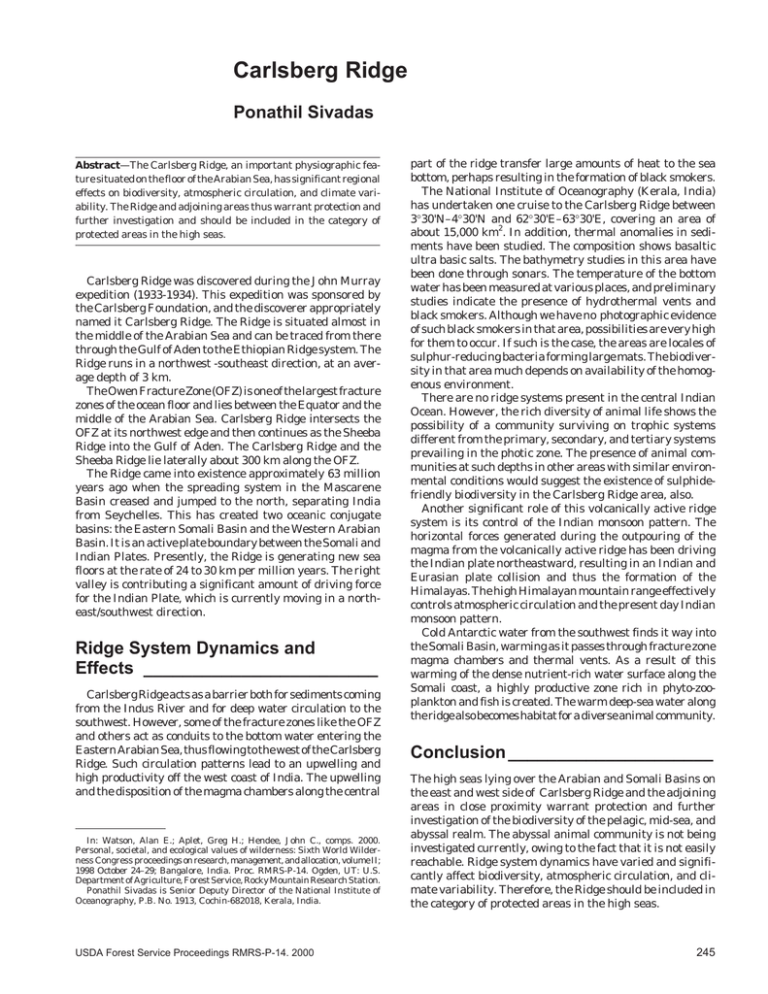Carlsberg Ridge Ponathil Sivadas
advertisement

Carlsberg Ridge Ponathil Sivadas Abstract—The Carlsberg Ridge, an important physiographic feature situated on the floor of the Arabian Sea, has significant regional effects on biodiversity, atmospheric circulation, and climate variability. The Ridge and adjoining areas thus warrant protection and further investigation and should be included in the category of protected areas in the high seas. Carlsberg Ridge was discovered during the John Murray expedition (1933-1934). This expedition was sponsored by the Carlsberg Foundation, and the discoverer appropriately named it Carlsberg Ridge. The Ridge is situated almost in the middle of the Arabian Sea and can be traced from there through the Gulf of Aden to the Ethiopian Ridge system. The Ridge runs in a northwest -southeast direction, at an average depth of 3 km. The Owen Fracture Zone (OFZ) is one of the largest fracture zones of the ocean floor and lies between the Equator and the middle of the Arabian Sea. Carlsberg Ridge intersects the OFZ at its northwest edge and then continues as the Sheeba Ridge into the Gulf of Aden. The Carlsberg Ridge and the Sheeba Ridge lie laterally about 300 km along the OFZ. The Ridge came into existence approximately 63 million years ago when the spreading system in the Mascarene Basin creased and jumped to the north, separating India from Seychelles. This has created two oceanic conjugate basins: the Eastern Somali Basin and the Western Arabian Basin. It is an active plate boundary between the Somali and Indian Plates. Presently, the Ridge is generating new sea floors at the rate of 24 to 30 km per million years. The right valley is contributing a significant amount of driving force for the Indian Plate, which is currently moving in a northeast/southwest direction. Ridge System Dynamics and Effects ________________________ Carlsberg Ridge acts as a barrier both for sediments coming from the Indus River and for deep water circulation to the southwest. However, some of the fracture zones like the OFZ and others act as conduits to the bottom water entering the Eastern Arabian Sea, thus flowing to the west of the Carlsberg Ridge. Such circulation patterns lead to an upwelling and high productivity off the west coast of India. The upwelling and the disposition of the magma chambers along the central In: Watson, Alan E.; Aplet, Greg H.; Hendee, John C., comps. 2000. Personal, societal, and ecological values of wilderness: Sixth World Wilderness Congress proceedings on research, management, and allocation, volume II; 1998 October 24–29; Bangalore, India. Proc. RMRS-P-14. Ogden, UT: U.S. Department of Agriculture, Forest Service, Rocky Mountain Research Station. Ponathil Sivadas is Senior Deputy Director of the National Institute of Oceanography, P.B. No. 1913, Cochin-682018, Kerala, India. USDA Forest Service Proceedings RMRS-P-14. 2000 part of the ridge transfer large amounts of heat to the sea bottom, perhaps resulting in the formation of black smokers. The National Institute of Oceanography (Kerala, India) has undertaken one cruise to the Carlsberg Ridge between 3∞30'N–4∞30'N and 62∞30'E–63∞30'E, covering an area of about 15,000 km2. In addition, thermal anomalies in sediments have been studied. The composition shows basaltic ultra basic salts. The bathymetry studies in this area have been done through sonars. The temperature of the bottom water has been measured at various places, and preliminary studies indicate the presence of hydrothermal vents and black smokers. Although we have no photographic evidence of such black smokers in that area, possibilities are very high for them to occur. If such is the case, the areas are locales of sulphur-reducing bacteria forming large mats. The biodiversity in that area much depends on availability of the homogenous environment. There are no ridge systems present in the central Indian Ocean. However, the rich diversity of animal life shows the possibility of a community surviving on trophic systems different from the primary, secondary, and tertiary systems prevailing in the photic zone. The presence of animal communities at such depths in other areas with similar environmental conditions would suggest the existence of sulphidefriendly biodiversity in the Carlsberg Ridge area, also. Another significant role of this volcanically active ridge system is its control of the Indian monsoon pattern. The horizontal forces generated during the outpouring of the magma from the volcanically active ridge has been driving the Indian plate northeastward, resulting in an Indian and Eurasian plate collision and thus the formation of the Himalayas. The high Himalayan mountain range effectively controls atmospheric circulation and the present day Indian monsoon pattern. Cold Antarctic water from the southwest finds it way into the Somali Basin, warming as it passes through fracture zone magma chambers and thermal vents. As a result of this warming of the dense nutrient-rich water surface along the Somali coast, a highly productive zone rich in phyto-zooplankton and fish is created. The warm deep-sea water along the ridge also becomes habitat for a diverse animal community. Conclusion _____________________ The high seas lying over the Arabian and Somali Basins on the east and west side of Carlsberg Ridge and the adjoining areas in close proximity warrant protection and further investigation of the biodiversity of the pelagic, mid-sea, and abyssal realm. The abyssal animal community is not being investigated currently, owing to the fact that it is not easily reachable. Ridge system dynamics have varied and significantly affect biodiversity, atmospheric circulation, and climate variability. Therefore, the Ridge should be included in the category of protected areas in the high seas. 245




